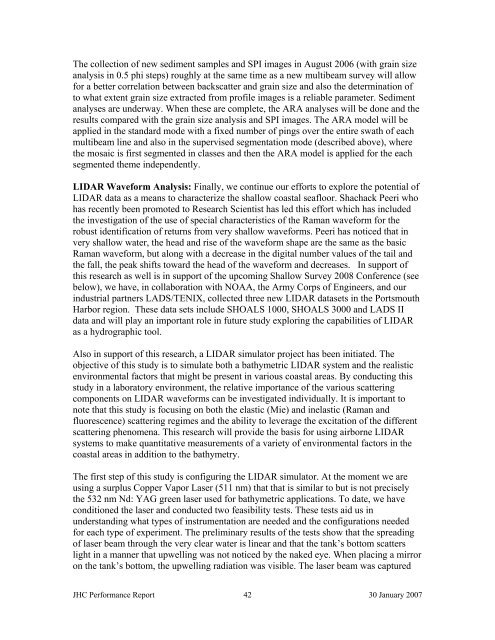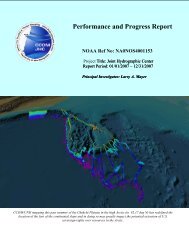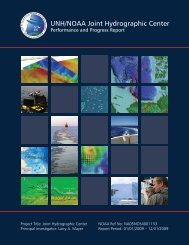Performance and Progress Report - John Doe FIX: put in the authors ...
Performance and Progress Report - John Doe FIX: put in the authors ...
Performance and Progress Report - John Doe FIX: put in the authors ...
You also want an ePaper? Increase the reach of your titles
YUMPU automatically turns print PDFs into web optimized ePapers that Google loves.
The collection of new sediment samples <strong>and</strong> SPI images <strong>in</strong> August 2006 (with gra<strong>in</strong> size<br />
analysis <strong>in</strong> 0.5 phi steps) roughly at <strong>the</strong> same time as a new multibeam survey will allow<br />
for a better correlation between backscatter <strong>and</strong> gra<strong>in</strong> size <strong>and</strong> also <strong>the</strong> determ<strong>in</strong>ation of<br />
to what extent gra<strong>in</strong> size extracted from profile images is a reliable parameter. Sediment<br />
analyses are underway. When <strong>the</strong>se are complete, <strong>the</strong> ARA analyses will be done <strong>and</strong> <strong>the</strong><br />
results compared with <strong>the</strong> gra<strong>in</strong> size analysis <strong>and</strong> SPI images. The ARA model will be<br />
applied <strong>in</strong> <strong>the</strong> st<strong>and</strong>ard mode with a fixed number of p<strong>in</strong>gs over <strong>the</strong> entire swath of each<br />
multibeam l<strong>in</strong>e <strong>and</strong> also <strong>in</strong> <strong>the</strong> supervised segmentation mode (described above), where<br />
<strong>the</strong> mosaic is first segmented <strong>in</strong> classes <strong>and</strong> <strong>the</strong>n <strong>the</strong> ARA model is applied for <strong>the</strong> each<br />
segmented <strong>the</strong>me <strong>in</strong>dependently.<br />
LIDAR Waveform Analysis: F<strong>in</strong>ally, we cont<strong>in</strong>ue our efforts to explore <strong>the</strong> potential of<br />
LIDAR data as a means to characterize <strong>the</strong> shallow coastal seafloor. Shachack Peeri who<br />
has recently been promoted to Research Scientist has led this effort which has <strong>in</strong>cluded<br />
<strong>the</strong> <strong>in</strong>vestigation of <strong>the</strong> use of special characteristics of <strong>the</strong> Raman waveform for <strong>the</strong><br />
robust identification of returns from very shallow waveforms. Peeri has noticed that <strong>in</strong><br />
very shallow water, <strong>the</strong> head <strong>and</strong> rise of <strong>the</strong> waveform shape are <strong>the</strong> same as <strong>the</strong> basic<br />
Raman waveform, but along with a decrease <strong>in</strong> <strong>the</strong> digital number values of <strong>the</strong> tail <strong>and</strong><br />
<strong>the</strong> fall, <strong>the</strong> peak shifts toward <strong>the</strong> head of <strong>the</strong> waveform <strong>and</strong> decreases. In support of<br />
this research as well is <strong>in</strong> support of <strong>the</strong> upcom<strong>in</strong>g Shallow Survey 2008 Conference (see<br />
below), we have, <strong>in</strong> collaboration with NOAA, <strong>the</strong> Army Corps of Eng<strong>in</strong>eers, <strong>and</strong> our<br />
<strong>in</strong>dustrial partners LADS/TENIX, collected three new LIDAR datasets <strong>in</strong> <strong>the</strong> Portsmouth<br />
Harbor region. These data sets <strong>in</strong>clude SHOALS 1000, SHOALS 3000 <strong>and</strong> LADS II<br />
data <strong>and</strong> will play an important role <strong>in</strong> future study explor<strong>in</strong>g <strong>the</strong> capabilities of LIDAR<br />
as a hydrographic tool.<br />
Also <strong>in</strong> support of this research, a LIDAR simulator project has been <strong>in</strong>itiated. The<br />
objective of this study is to simulate both a bathymetric LIDAR system <strong>and</strong> <strong>the</strong> realistic<br />
environmental factors that might be present <strong>in</strong> various coastal areas. By conduct<strong>in</strong>g this<br />
study <strong>in</strong> a laboratory environment, <strong>the</strong> relative importance of <strong>the</strong> various scatter<strong>in</strong>g<br />
components on LIDAR waveforms can be <strong>in</strong>vestigated <strong>in</strong>dividually. It is important to<br />
note that this study is focus<strong>in</strong>g on both <strong>the</strong> elastic (Mie) <strong>and</strong> <strong>in</strong>elastic (Raman <strong>and</strong><br />
fluorescence) scatter<strong>in</strong>g regimes <strong>and</strong> <strong>the</strong> ability to leverage <strong>the</strong> excitation of <strong>the</strong> different<br />
scatter<strong>in</strong>g phenomena. This research will provide <strong>the</strong> basis for us<strong>in</strong>g airborne LIDAR<br />
systems to make quantitative measurements of a variety of environmental factors <strong>in</strong> <strong>the</strong><br />
coastal areas <strong>in</strong> addition to <strong>the</strong> bathymetry.<br />
The first step of this study is configur<strong>in</strong>g <strong>the</strong> LIDAR simulator. At <strong>the</strong> moment we are<br />
us<strong>in</strong>g a surplus Copper Vapor Laser (511 nm) that that is similar to but is not precisely<br />
<strong>the</strong> 532 nm Nd: YAG green laser used for bathymetric applications. To date, we have<br />
conditioned <strong>the</strong> laser <strong>and</strong> conducted two feasibility tests. These tests aid us <strong>in</strong><br />
underst<strong>and</strong><strong>in</strong>g what types of <strong>in</strong>strumentation are needed <strong>and</strong> <strong>the</strong> configurations needed<br />
for each type of experiment. The prelim<strong>in</strong>ary results of <strong>the</strong> tests show that <strong>the</strong> spread<strong>in</strong>g<br />
of laser beam through <strong>the</strong> very clear water is l<strong>in</strong>ear <strong>and</strong> that <strong>the</strong> tank’s bottom scatters<br />
light <strong>in</strong> a manner that upwell<strong>in</strong>g was not noticed by <strong>the</strong> naked eye. When plac<strong>in</strong>g a mirror<br />
on <strong>the</strong> tank’s bottom, <strong>the</strong> upwell<strong>in</strong>g radiation was visible. The laser beam was captured<br />
JHC <strong>Performance</strong> <strong>Report</strong> 42 30 January 2007




